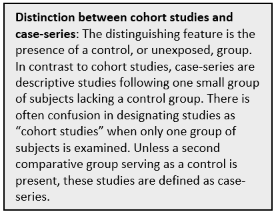6. Types of Descriptive Studies
| Site: | EUPATI Open Classroom |
| Course: | Epidemiology and Pharmacoepidemiology |
| Book: | 6. Types of Descriptive Studies |
| Printed by: | Guest user |
| Date: | Thursday, 3 April 2025, 11:39 AM |
1. Types of Descriptive Studies
(This section is organised in the form of a book, please follow the blue arrows to navigate through the book or by following the navigation panel on the right side of the page.)
Descriptive studies, as the name implies,
describe conditions or diseases. In particular, descriptive studies identify
patterns in person, place, and time. These types of study involve no comparison
group. They are merely descriptive. The most basic types are: a case report, a
case series, an incidence study and a cross-sectional study and are briefly
described in the following.
1.1. Case Reports and Case Series
These are descriptive studies of one (case study or case report) or a series of patients (case series) defined by eligibility criteria, and where the unfolding course of events (disease progression, therapies, outcomes, etc.) is described in detail and where interventions are not manipulated. This study design is used to provide a detailed description of an uncommon disease or condition, a specific situation, or unique therapeutic approaches. Reports provide retrospective safety and efficacy details, as well as other clinical parameters (e.g., quality of life [QoL]) derived from cases of interest in their natural clinical setting.

1.2. Incidence studies
An incidence study is set up to investigate the incidence of a disease by measuring the number of new cases of a disease or condition, during a specific time in a specific population. One advantage of incidence studies is that they allow calculation of true rates of disease occurrence for a better estimation of risk.
1.3. Cross-sectional studies
See also Descriptive Cross-sectional study
Examples for the three above mentioned types of descriptive studies based on infections with the West Nile virus:
- Case reports describe individual data, (e.g., on a form, a report in a medical journal). West Nile virus in a transfusion or transplant recipient might be reported as a case report.
- A case series for West Nile virus might be presented in a table that lists and describes all West Nile cases in the Northwest
- An incidence study could use a map to display all the new West Nile cases in the north western United States in a defined year.